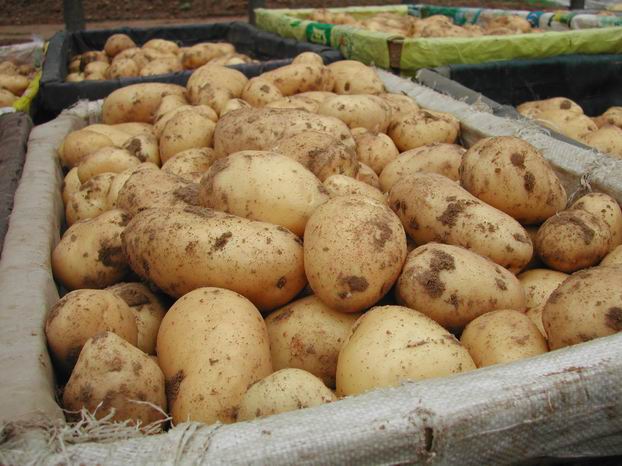 The benefits of potatoes to humans are undeniable. It is called "second bread", as it is a very common food product. They began to cultivate this vegetable under Peter 1. But not immediately he won love among the people, because of ignorance they first used green “bulbs” for food, which led to poisoning.
The benefits of potatoes to humans are undeniable. It is called "second bread", as it is a very common food product. They began to cultivate this vegetable under Peter 1. But not immediately he won love among the people, because of ignorance they first used green “bulbs” for food, which led to poisoning.
Only having figured out that the tubers are edible in this vegetable, they began to distribute potatoes in different areas.
Content
The relationship between potato varieties and harvest dates
Gardeners who own household plots try to meet their needs for vegetables on their own. The first place among them, of course, is potato. Since, due to weather conditions in different regions, planting time may be delayed, the timing of potato ripening is determined separately. To get a good harvest, you need to choose a variety that is suitable for cultivation in this climate zone.
By maturity and vegetation period, varieties are divided into types:
- Early, matures in 2 months;
- Sredneranny, vegetation of which 70-80 days;
- Mid-season - ready for harvesting in 85–95 days;
- Medium late, from sowing to harvesting 100-110 days;
- Late, for its technical maturity it will take at least 110 days.
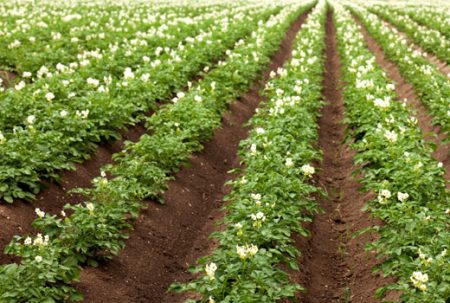
The goal of each grower is to get a high yield of well-ripened, forming a dense skin of potatoes. The decisive features when choosing a variety, in addition to the ripening and growing time, are the purpose of the variety, resistance to nightshade diseases, taste, the possibility of long-term storage without loss of nutritional value. The right decision to grow several varieties simultaneously with a consistent maturity.
What factors influence the ripening period
There is no exact maturity date. It is individual for each variety, as several factors influence this process: planting dates, potato variety, proper care, amount of fertilizers applied, soil fertility, and regional climate.
- Early planted vegetable before and dig up. But there is a threat of death from spring cold.
- A lack of moisture shortens the ripening period, but affects the yield, which is small and with small tubers.
- Growing in poor, depleted soil gives the same result - tubers will ripen quickly, but they are tied in small quantities.
- Excess fertilizer in the soil lengthens the growing season. The plant supplies not so much roots as it builds up green mass and grows up. Harvested tubers do not have time to ripen and contain a large amount of nitrates.
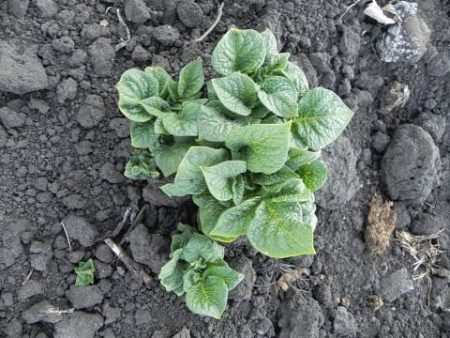
When the potato stops its development, the stems dry up and the tops die off - this is the first sign that it is time to harvest.
It must be removed within 20 days. If you tighten the collection time, this will not have the best effect on the duration of storage of the crop. If the tops remain green, despite the cooling, take measures to accelerate the ripening of tubers. When frosts are urgently harvested, otherwise the potatoes will spend their useful substances on updating the tops.
Potato growing season
In order to have vegetables grown by hand throughout the season, often several varieties of potatoes with different ripening periods are simultaneously grown on the same site. The full period of root vegetation lasts from 70 to 140 days. This stage is due to varietal properties and cultivation conditions.
What is vegetation?
Vegetation is a period of time during which seedlings go through the active phase of their growth. The biological feature of potatoes is the ability to form underground shoots, with tubers at the ends. Due to the fact that the tuber is a vegetative organ of potatoes, the root crop needs a loose, moderately moist soil. The optimum temperature for tuberization is 15-18 C.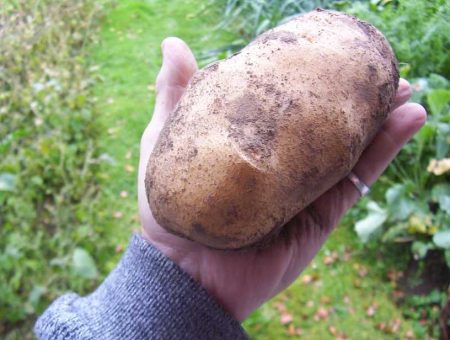
Potato vegetation can be divided into several stages. The first is the time from sowing and the appearance of the first seedlings to the formation of buds (30-36 days - early ripening, 43-47 - late ripe varieties). During this period, the plant mainly increases the mass of tops. The second stage covers the beginning of flowering and lasts until the final formation of green mass. Tuber growth at this time is the most intense. The third is a slowdown in the growth of tops and its subsequent death, which indicates the ripening of tubers. Potato ripening time after flowering is approximately one and a half to two months. These terms are individual and the time taken to complete these stages in different regions still depends on the care of the plantings and on the variety of planting tubers.
Ways to bring potato to maturity
Delayed planting and adverse weather conditions, when the peel does not have time to form and can be damaged during harvesting, lead to a reduction in the shelf life of the root crop. Then there is a need to bring the ripening of potatoes closer.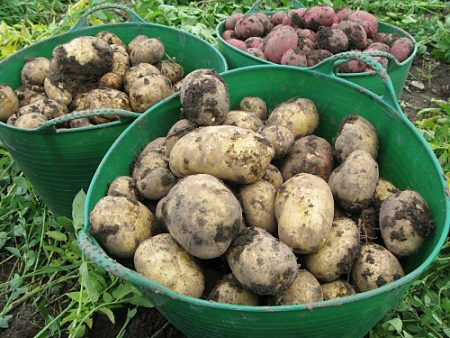
You can speed up the receipt of a marketable root crop by mowing tops or using chemical preparations.
- Mowing green tops 7-10 days before harvesting is a simple and effective technique. The signal for the plant to the end of the growing season and the ripening of tubers.
- Spraying with a solution of copper sulfate (5 g per 1 liter of water) 10-14 days before the expected date of harvest, draws all the water from the green mass, which leads to its drying.
- Treatment with magnesium chlorate (20 g per 1 liter of water) will accelerate the drying of the tops after the rainy season.
- A superphosphate solution (2kg per 1 bucket of water) will also accelerate the aging of the green mass of potatoes.
Spraying is carried out after flowering in the daytime or in the evening, spending 5-10 liters of chemical solutions per hundredth.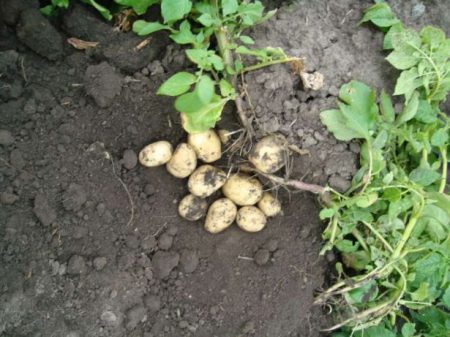
Weather conditions for digging potatoes
When most of the potato tops have withered, then the time has come to start harvesting. If rainfall is approaching, you should hurry with the harvest so that excess moisture at the end of the growing season does not provoke the development of putrefactive diseases of the potato. To keep the potatoes well, you need to dig and sort it on a warm, sunny day closer to noon at an optimal air temperature of 12-17 C. After drying the tubers under a canopy and put them away for storage. Potatoes intended for planting can be kept in the light (for landscaping).
Using agricultural techniques, selection and preparation of tubers for planting, you can increase productivity. And correctly and timely harvested crops, will save potatoes until spring.
Feedback
Each gardener has his own methods and methods for growing potatoes. I want to share my experience. I prepare planting material in the fall. I select medium-sized tubers from a crop bush. I warm them well in the light. I keep them in the cellar, preventing them from germinating before March. In March I bring the boxes with tubers into the room. If the sprouts appear slowly, then I moisten them with warm water. This technique is good in that you can immediately determine the fertility of these tubers in the future by the number and thickness of the sprouts. Planted in April, while the soil is still wet. I pour a handful of ash, husks from onions and garlic into the holes (I collect the whole winter). If there is no humus, then a pinch of nitroammofoski. That's all the tricks. Before emergence, I remove the weeds.And when green shoots appear, 15 cm high, I begin to loosen the soil and spud the bushes. When the sprouts begin to tie flower buds, I begin to water the beds well and do the second hilling. I periodically inspect the bushes, not allowing the familiar Colorado beetle to appear on them. And in the end I get a huge crop of even, coarse tubers. And the fact that my work was not in vain - it pleases !!!!




 Description and description of varieties in Belarus with a photo
Description and description of varieties in Belarus with a photo Do I need to pick flowers from potatoes: why do they do it
Do I need to pick flowers from potatoes: why do they do it When to dig potatoes: timing and availability of new potatoes
When to dig potatoes: timing and availability of new potatoes How to grow a good potato crop: various methods and methods, planting and care
How to grow a good potato crop: various methods and methods, planting and care